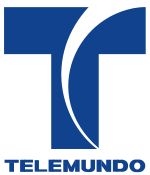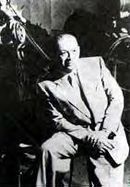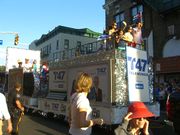Telemundo
 |
|
| Type | Spanish-language Broadcast Television Network |
|---|---|
| Country | United States (the signal is capted in Mexico in frontier cities), Puerto Rico
Headquarters: Hialeah, Florida |
| Availability | International |
| Founded | by Ángel Ramos |
| Slogan | "Atrévete a más" ("Dare for more") |
| Area | United States, Canada, Mexico, and Puerto Rico |
| Owner | • NBC Universal • |
| Launch date | • 1954, as WKAQ-TV in San Juan, Puerto Rico • 1987 in the continental United States (KVEA of Los Angeles was the first Telemundo-owned & operated station launched in 1985) |
| Former names | None |
| Official Website | www.telemundo.com |
Telemundo is an American television network that broadcasts in Spanish. The network is the second-largest Spanish-language content producer in the world,[1] and the second-largest Spanish-language network in the United States, behind Univision.
Telemundo reaches 93 percent of Hispanic and Latino American households in 142 markets via over-the-air, cable, and satellite television.[2] An average of 1,035,000 total viewers (aged 2 and older) tuned in for its weekday prime time lineup during 2007.[3] Telemundo is the only Spanish-language network that produces most of its telenovelas.[4] Unlike Univision, which only has Spanish captions, many programs on Telemundo air with closed captions in both Spanish and English.
Telemundo was founded by Ángel Ramos with a television station in San Juan, Puerto Rico in 1954. Telemundo Communications Group, the network's parent company, is part of the NBC Universal division of General Electric, which paid $2.7 billion for Telemundo in 2002. Don Browne is Telemundo's president. Jeff Gaspin, who is president and COO of Universal Television Group, oversees the network. Telemundo has 1,800 employees,[5] and is headquartered at 2290 West 8th Avenue in Hialeah, a Miami, Florida suburb.[6]
Contents |
History
1954–1987

WKAQ-TV launched the Telemundo brand on March 28, 1954. The station was founded by Ángel Ramos, owner of El Mundo, Puerto Rico's main newspaper at the time, and of Puerto Rico's first radio station, WKAQ, also known as "Radio El Mundo". Ramos wanted to maintain a consistent branding for his properties using the mundo theme (Spanish for "world"), and thus named WKAQ-TV Telemundo (in effect, "Teleworld" or "World TV"). He had tried to obtain a television license as early as the mid-1940s, but due to a Federal Communications Commission (FCC) licensing freeze for all new American television stations, Ramos had to wait until 1954 to obtain the license.[7]
In the beginning, Ramos maintained continuity between his radio and television stations by signing an exclusive deal with the most famous and influential actor/comedian/producer in Puerto Rico, Ramón Rivero, better known as Diplo, whose "Tremendo Hotel", broadcast through WKAQ Radio, was the most popular radio show ever in Puerto Rico. It was Rivero who produced the first comedy/variety television shows for WKAQ Telemundo, La Taberna India, and then La Farándula Corona, shows that catapulted WKAQ to the top of the ratings.
During the 1970s and 1980s, WKAQ-TV, then branded as Telemundo Canal 2, was a major producer of soap operas. The channel was also known by its "fingers" logo—a bold number "2" with the silhouette of two upright fingers inside the number—and called itself "El canal de los dedos" (the channel of the fingers).
1985–1987
In 1985, Estrella Communications, owned by Joe Wallach, Paul Niedermeyer, and Reliance Group Holdings, purchased KVEA in Los Angeles. It became the first full-time independent Spanish language station in Los Angeles. The next year, Reliance acquired the Telemundo brand when it purchased Blair Broadcasting. The purchase included WSCV in Ft. Lauderdale/Miami and Puerto Rico's WKAQ-TV (known for decades as "Telemundo Canal 2"). In late 1986, Reliance purchased New Jersey station WNJU serving the New York City metropolitan area.
In 1987, Saul Steinberg and Henry Silverman of Reliance Capital Group merged all these stations into the Telemundo Group.[8] The new corporation quickly went public and launched the Telemundo network. Later that year, it purchased additional stations in San Francisco, Houston and San Antonio.
Expansion
Between 1988 and 1991, Telemundo acquired stations in Texas, New Mexico, Arizona, and Washington, DC. The network decided to outsource its news division in 1988; CNN produced two newscasts, branded Noticiero Telemundo CNN (lit. "Telemundo CNN Newscast"). Produced in Atlanta, Noticiero Telemundo CNN was anchored by Jorge Gestoso and María Elvira Salazar. Lana Montalbán, who anchored the show known then as Telemundo HBC, returned to New York City, where she anchored the WNJU newscast for four years. When Salazar decided to take a reporter's position at Noticiero Univision in Miami, Chilean former Miss Universe Cecilia Bolocco joined Gestoso. The final incarnation produced in Atlanta was co-anchored by Patricia Janiot.
In 1994, Telemundo caught the fever of producing 24-hour news. The network launched Telenoticias partnering with Argentina's Artear Network, Antena 3 of Spain, and Reuters. The venture was not successful and the service was sold to CBS. Rebranded as CBS Telenoticias, the network did air all over the Americas.
CBS Telenoticias was sold back to Telemundo and the network branded it Telemundo Internacional.
1992–1998
In 1992, Telemundo went through another management change, as it received former Univision president Joaquin Blaya, who left Univison with four other executives. The next year, Telemundo branded itself with the campaign Arriba, Telemundo, Arriba (lit. "Upwards, Telemundo, Upwards"). Around the same time, the famed Telemundo "T" logo was introduced.

In 1993, Telemundo began the ongoing practice of producing original telenovelas. The first soaps were Angélica, mi vida, Marielena, Guadalupe, Señora Tentación, and Tres Destinos. International markets and syndicators soon courted these shows. Telemundo's effort faced an initial setback when Mexico's industry leader, Televisa, bought Capitalvision, the production house that had been making the new soap operas.
In 1995, under the direction of Harry Abraham Castillo, the network's Executive Vice-President of Programming, Telemundo opened its first network studio on the West Coast. On the Raleigh Studios lot in Hollywood, three shows began daily production: La Hora Lunática, hosted by LA radio personality Humberto Luna; El y Ella, a daily talkshow created and hosted by Gigi Graciette; and Dando y Dando, a gameshow hosted by Rafael Sigler.
1998–2001
In 1998, Telemundo was bought by a partnership between cable's Liberty Media and conglomerate Sony Pictures Entertainment. Helmed by yet another management team under the leadership of former CBS executive Peter Tortoricci, hopes of attracting the bilingual market were explored. The Lo mejor de los dos Mundos ("The best of both Worlds") campaign was launched. Several billboards went up in cities such as Miami and San Francisco heralding a "new era" for Telemundo. Former CBS News Vice President Joe Peyronnin founded Telemundo's network news division in 1999 and served as its Executive Vice-President until 2006.
After Tortoricci's resignation Telemundo was lead by Jim McNamara as CEO and Alan Sokol as COO. Their programming strategy followed a more traditional approach to Spanish language television than their predecessors, since the new team incorporated several telenovelas from Colombia and Brazil and entertainment programs. It was under McNamara that Telemundo incorporated Laura en América, hosted by Peruvian lawyer Laura Bozzo; Betty La Fea ("Ugly Betty"; lit. "Betty The Ugly"), starring Ana Maria Orozco; A Oscuras Pero Encendidos, hosted by Paul Bouche; Xica, starring Tais Araujo; the Spanish game show Números Rojos; and the Argentine children's program Agrandaditos.[9]
2001–Present, and future

On April 12, 2002, Telemundo was purchased by NBC for $2.7 billion and is now a part of NBC Universal.[5] Jim MacNamara remained at the helm of the network. Local stations began producing early morning news to be more competitive in their respective markets; The Telemundo "T" logo received an overhaul. Telemundo's main competitor, Univision, continued to have an upper hand in the ratings, although not in all time slots.
News programs were created in the wake of 9/11. "Hoy en el Mundo" ("Today in the World"), anchored by Marian de la Fuente and Jose Diaz-Balart, went on the air informing viewers of national and international events. This program and its companion show "De Mañanita" ("In Early Morning") were cancelled due to the much heralded arrival of Maria Antonieta Collins from Univision. "Cada Día con Maria Antonieta" ("Every Day with Maria Antonieta") went on the air in October 2005. She continued to host the program along with the much recycled Diaz-Balart as co-host. Diaz-Balart was anchor of Telemundo's morning news program called "Noticiero Telemundo: Primera Hora" ("Telemundo Newscast: Early Morning"), later to be anchored by Ana Patricia Candiani.
In 2004, Telemundo created Telemundo Television Studios in Miami. The network also began subtitling many of its telenovelas into English via closed captioning. Under NBC, Telemundo gave greater emphasis to original programming and product placement. The network was spending $100 million a year producing its own shows around mid-decade.[5]
NBC officials asked McNamara to resign and replaced him with Don Browne, in 2005. Browne had been head of the NBC affiliate WTVJ in Miami.
In March 2007, NBC Universal announced that it had restructured Telemundo's entertainment division in an effort to narrow Univision's ratings dominance.[10] Starting in the fall of 2007, the network was to have cut the first commercial break in every prime time show to only 60 seconds in length.[11] It also planned to air the 2008 series Idolos de Juventud uninterrupted, using pervasive product placement instead of traditional ad spots.[12] NBC also announced the intention to dispose of the original Telemundo station in Puerto Rico (Channel 2) and Los Angeles' KWHY to finance the acquisition of Oxygen Media. On 21 December 2007, NBC Universal announced that WKAQ-TV was no longer for sale, indicating that Telemundo Puerto Rico would stay within the NBC family.[13]
On March 18, 2008 Grupo Televisa and NBC Universal announced a 10-year multiplatform agreement that would allow 1000 hours of Telemundo programming, including news, entertainment, specials, and sports, to be broadcast over not only Televisa's free-to-air channels, but also Televisa's SKY Channel and cable system starting in April, as well as a planned Telemundo pay channel to be launched later in the year. On October 8, 2008, Hillary Hattler the station's president gathered several employees and offered them a "retirement plan", but the initiative gathered criticism from most of those present in the meeting.[14]

Collins announced in 2008 that she was to leave Telemundo when her contract expired in August that year and that she wished to return to news anchoring.[15] "Cada Dia" was cancelled that May due to low ratings, and was replaced by a new morning show called "Levántate" ("Get up"), which aired live from Telemundo's WKAQ-TV, with segments out of WSCV in Miramar, Florida, and also out of New York, Los Angeles, and Mexico studios.
On November 14, 2008 it was announced that Telemundo would end its two-year online relationship with Yahoo! in January 1, 2009 to launch a standalone hub at telemundo.com, with Microsoft as content distributor.[16]
On April 23, 2009 Telemundo became the first U.S.-based Spanish-language network to begin airing its prime time programming in 1080i 16:9 high definition. Initially, Telemundo O&Os in nine markets (New York, Los Angeles, Chicago, Dallas-Fort Worth, San Francisco, Houston, Miami, Las Vegas, and Puerto Rico) were to air Telemundo programming in HD. The remaining O&Os were to phase in HD programming over the next twelve months. It was unknown if and when third-party-owned affiliates would follow suit.
Telemundo and Televisa launched a jointly owned network in Mexico in August 2009. The new network is available on cable and satellite in Mexico.
Telemundo produces far more programming than Univision, whose schedule is heavy on Mexican and Venezuelan shows due to long-term exclusive deals with media giants Televisa and Venevisión.
Programming
Primetime and daytime schedule
Telemundo airs its 8–11 pm (ET/PT) weekday programs (usually telenovelas) using a form of the Turner Time scheduling strategy used by TBS from 1981 until 1997. That is to say, each program starts a few minutes after its officially scheduled time, typically three or four minutes after the hour. Shows also bleed over into the next time slot. This encourages viewers to stay tuned to Telemundo instead of joining another channel's program in progress. The 11 pm news broadcasts start at the conventional time, however. The reverse is the case on weekends when football matches are aired, when all programs airing prior to the game are aired five minutes before the hour or half-hour; on weekend days when football matches are not aired, regularly scheduled programming is aired in their conventional timeslots.
The movie blocks typically show dubbed Hollywood films. The Disney anthology, El Maravilloso Mundo de Disney, airs monthly.
English subtitles
Telemundo is the only US Spanish-language network to provide English subtitles of its weekday prime-time programming. They appear as closed captions on CC3 in standard definition and digital service 2 in HDTV. The network produces the translations in-house and intends them to attract Hispanic viewers who may not be fluent in Spanish.[17] Programs appear with a special digital on-screen graphic at the start of each episode (see right).
Programs which had English captions during their original broadcast will also have them in repeats. Some programs (notably the long-running anthology, Decisiones), have translations in some episodes but not others, depending on when they were produced. Availability of English subtitles is limited to the technical capacity of the local station, cable or satellite provider, or other outlet to pass them on.
The captions premiered with La Cenicienta and Amor Descarado on September 8, 2003.[17] This generated a small, loyal fan base among English-speaking viewers.[18] Subtitles briefly disappeared without notice starting October 14, 2008, amid budget cuts at Telemundo. The network cited the need to concentrate resources on its core Spanish-speaking audience, but soon reversed the cancellation due to popular demand.[18] They began reappearing on March 30, 2009.
See also
- List of United States television networks
- List of Telemundo affiliates (by state and city)
Notes
- ↑ Breaking News - In Landmark Move, NBC Universal Television Group Signs Development Deal With Galan Entertainment For Production Of Telenovelas In English Across Its Many Networks | Thefutoncritic.Com
- ↑ Breaking News - In Landmark Move, Nbc Universal Television Group Signs Development Deal With Galan Entertainment For Production Of Telenovelas In English Across Its Many Networks | Thefutoncritic.Com
- ↑ [1]
- ↑ Clorox and Wal-Mart Team up With Telemundo on New Episodes of Dame Chocolate Telenovela
- ↑ 5.0 5.1 5.2 James, Meg. NBC tacks on Telemundo oversight to Gaspin's tasks. Los Angeles Times, July 26, 2007. Retrieved on May 14, 2010.
- ↑ "Legal corporate english." Telemundo. Retrieved on February 3, 2009.
- ↑ "Corporate Information." Telemundo. Retrieved on February 3, 2009.
- ↑ "TELEMUNDO - The Museum of Broadcast Communications". Museum.tv. http://www.museum.tv/archives/etv/T/htmlT/telemundo/telemundo.htm. Retrieved 2010-04-27.
- ↑ Sutter, Mary. Telemundo sets fall sked. Variety, May 16, 2000. Retrieved 2008-02-24.
- ↑ Telemundo divisions to be revamped - Entertainment News, TV News, Media - Variety
- ↑ [2]
- ↑ [3]
- ↑ WKAQ-TV "Telenoticias a las 5:00 P.M." in a short message by Don Browne (NBC/Telemundo Network president).
- ↑ Rosalina Marrero-Rodríguez (2008-10-10). "¿Telemundo los quiere retirar temprano?" (in Spanish). Primera Hora. http://www.primerahora.com/noticia/otros_asi/espectaculos_asi/¿telemundo_los_quiere_retirar_temprano?/237639. Retrieved 2008-10-11.
- ↑ In an interview in "People En Espanol".
- ↑ [4]
- ↑ 17.0 17.1 "Commentary: Telemundo will use English captions". Quickstart.clari.net. 2003-09-07. http://quickstart.clari.net/qs_se/webnews/wed/da/Uus-telemundo-captions.Rylp_DS7.html. Retrieved 2010-04-27.
- ↑ 18.0 18.1 "Telenovelas: Doña Barbara And "The Picture In My Head"". Telenovelas-carolina.blogspot.com. 2008-08-05. http://telenovelas-carolina.blogspot.com/2008/08/doa-barbara-and-picture-in-my-head.html. Retrieved 2010-04-27.
External links
- Official Site
- Telemundo International
- Telemundo, from the Museum of Broadcast Communications website
- NBC Universal's media village website
|
|||||
|
|||||
|
|||||
|
|||||
|
|||||
|
|||||
|
|||||
|
|||||
|
||||||||||||||||||||
|
||||||||||||||||||||||||||||||||||||||||||||||||||||||||
|
||||||||||||||||||||||||||||||||||||||||||||||||||||||||||||||||||||||||||||||||||||||||||||||||||||||||||||||||||||||||||||||||||||||||||||||||||||||